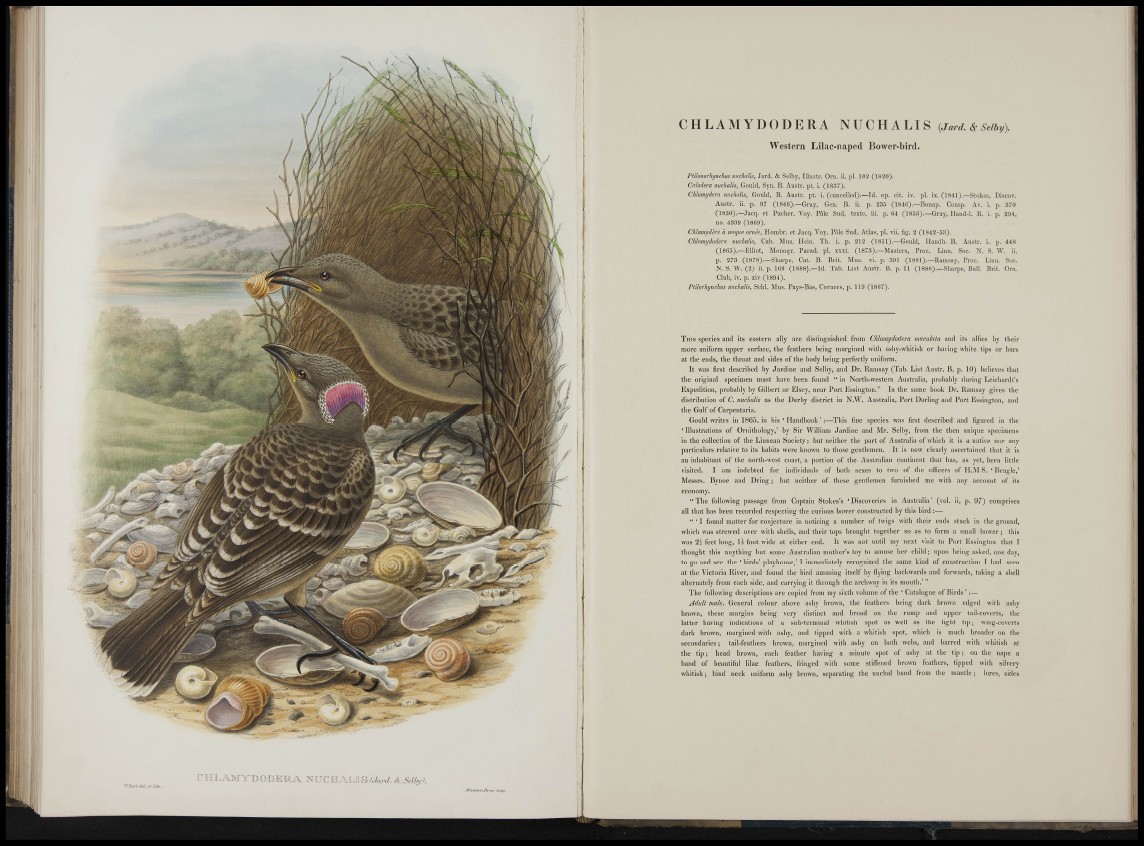
,M f.t Lilh .
C H L A M Y D O D E R A N U C H A L l l S - ^W. rt At tv' ,
.ifi'iittfri Bfc^. intf).
CHLAMYDODERA NUCHALIS (Jard, Seib^).
Western Lilac-naped Bower-bird.
Ptilonoi-hynchis michalis, Jard. & Selby, Illustr. Orn. ii. p i 102 (1820).
Calodera michalis, Gould, Syn. B. Austr. pt. i. (1837).
CUmmjdem michalis, Gould, B. Austr. pt. i. (cancelled).—Id. op. cit. iv. pi. ix. (1841).—Stokes, Discov.
Austr. 11. p. 97 (1846).—Gray, Gen. B. 11. p. 235 (1846).—Bonap. Consp. Av. 1. p. 370
(1850).—Jacq. et Puclier. Voy. Pôle Sud, texte, 111. p. 64 (1853).—Gray, Iland-l. B. 1. p. 294,
no. 4339 (1869).
Chlamijière à mique ornée, Hombr. et Jacq. Yoy. Pôle Sud, Atlas, pl. vil. fig. 2 (1842-53).
Chlamyiodera michalis. Cab. Mus. Heln. Tli. 1. p. 212 (1851).—Gould, Handb. B. Austr. i. p. 448
(1865).—Elliot, Monogr. Parad. pi. xxxi. (1873).—Masters, . P roc . Linn. Soc. N. S. W. ii.
p. 273 (1878).—Sharpe, Cat. B. Brit. Mus. TI. p. 391 (1881).—Ramsay, Proc. Linn. Soc.
N. S. W. (2) ii. p. 169 (1888).—Id. Tab. List Austr. B. p. 11 (1888).—Sharpe, Bull. Brit. Orn.
Club, IY. p. XIT (1894).
Ptilorhynchns michalis, Schl. Mus. Pays-Bas, Coraces, p. 119 (1867).
THIS species and its eastern ally are distinguished from Chlmmjdodera maculata and its allies by their
more uniform upper surface, the feathers being margined with ashy-whitish or having wiiite tij>s or bars
a t the ends, the throat and sides of the body being perfectly uniform.
I t was first described by Jardine and Selby, and Dr. Ramsay (Tab. List Aastr. B. p. 10) believes that
the original specimen must have been found " in North-western Australia, probably during Leichardt's
Expedition, probably by Gilbert or Elsey, near Port Essington." In the same book Dr. Ramsay gives the
distribution of C. michalis as the Derby district in N.W. Australia, Port Darling and Port Essington, and
t h e Gulf of Carpentaria.
Gould writes in 1865, in his ' H a n d b o o k ' :—Th i s fine species was first described and figured in the
' Illustrations of Ornithology,' by Sir William Jardine and Mr. Selby, from the tiien unique specimens
in the collection of the Linnean Society; but neither the part of Australia of vvliich it is a native nor any
p a r t i c u l a r s relative to its habits were known to those gentlemen. It is now clearly ascertained that it is
an inhabitant of the north-west coast, a portion of the Australian continent that has, as yet, been little
visited. I am indebted for individuals of both sexes to two of the officers of H.M S. ' Beagle,'
Messrs. Bynoe and Dring; but neither of these gentlemen furnished me with any account of its
economy.
" Tile following passage from Captain Stokes's ' Discoveries in Australia' (vol. ii. p. 97) comprises
all that has been recorded respecting the curious bower constructed by this bird :—
" ' I found matter for conjecture in noticing a number of twigs with their ends stuck in the ground,
which was strewed over with shells, and their tops brought together so as to form a small bower ; this
was 2 i feet long, l i foot wide at either end. It was not until my next visit to Port Essington tliat I
thought this anything but some Australian mother's toy to amuse her child ; upon being a.sked, one day,
to go and see the ' birds' playhouse,' I immediately recognized the same kind of construction I bad seen
a t the Victoria River, and found the bird amusing itself by flying backwards and forwards, taking a shell
alternately from each side, and carrying it through the arcliway in its mouth.' "
T l i e following descrijitions are copied from my sixth volume of the ' Catalogue of Birds ' : —
^ilult male. General colour above ashy brown, the feathers being dark brown edged with ashy
brown, these margins being very distinct and broad on the rump and upjier tail-coverts, the
l a t t e r having indications of a sub-terminal whitish spot as well as the light tip; wing-coverts
dark brown, margined with ashy, and tijiped with a whitish S])Ot, which is much broader on the
s e c o n d a r i e s ; tail-feathers brown, margined with ashy on both webs, and barred with whitish at
t h e tip; head brown, each feather having a minute spot of as by at the tip; on the nape a
band of beautiful lilac feathers, frhiged with some stiffened brown feathers, tipped with silvery
w h i t i s h ; hind neck uniform ashy brown, separating the nuchal band from the mantle; lores, sides